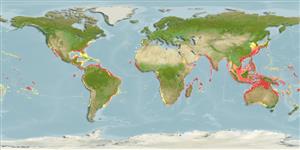分类 / Names
俗名 | 同种异名 | Catalog of Fishes(属, 种) | ITIS | CoL | WoRMS | Cloffa
Teleostei >
Carangiformes (Jacks)
鱸形目 (Jacks) >
Carangidae (Jacks and pompanos) > Naucratinae
Etymology: Seriola: Latin word diminutive with the meaning of a large earthenware pot (Ref. 45335).
More on author: Valenciennes.
Environment: milieu / climate zone / depth range / distribution range
生态学
海洋 礁区鱼类; 深度上下限 5 - 245 m (Ref. 90102), usually 30 - 35 m (Ref. 40849). 亚热带的; 43°N - 38°S, 180°W - 180°E
Circumglobal. Indo-West Pacific: Kenya south to South Africa (Ref. 3287) and east to Mariana and Wake islands in Micronesia, north to the Ryukyu Islands, south to New Caledonia and the Kermadec Islands (Ref. 8879). Absent from the Red Sea and French Polynesia. Likely at Seychelles (Ref. 1623). Eastern Pacific: USA to Peru, including Galapagos Islands (Ref. 2850). Western Atlantic: Cape Cod, USA to northern Argentina (Ref. 9626). Distribution in the eastern Atlantic is not well established. Recently recorded from Lampedusa Island in the Mediterranean (Ref. 47878).
Circumglobal。 印度-西太平洋: 肯亚南至南非 (参考文献 3287) 而且东至在密克罗尼西亚的马里亚纳群岛与维克岛, 北至琉球群岛, 南至新加勒多尼亚与科玛狄克群岛.(参考文献 8879) 红海与法属玻里尼西亚没有出现。 或许在塞锡尔群岛.(参考文献 1623) 东太平洋: 美国到秘鲁, 包括加拉巴哥群岛.(参考文献 2850) 西大西洋: 美国科德角到阿根廷北部.(参考文献 9626) 在东大西洋的分布很好地不被建立。 最近从在地中海中的 Lampedusa 岛记录。(參考文獻 47878)
大小 / 重量 / 年龄
Maturity: Lm ? range ? - ? cm
Max length : 160 cm FL 雄鱼/尚未辨别雌雄; (Ref. 40637); common length : 90.0 cm TL 雄鱼/尚未辨别雌雄; (Ref. 5450); 最大体重: 59.9 kg (Ref. 40637)
背棘 (总数): 8; 背的软条 (总数): 27-33; 臀棘 3; 臀鳍软条: 18 - 22; 脊椎骨: 24. This species is distinguished by the following characters: upper jaw posterior very broad, extends to level of middle of pupil; gill rakers (excluding rudiments) decreasing slightly in number with growth, 6-9 + 18-20 = 24 -29 in 2-7 cm FL individuals, but 22-26 in fish larger than 20 cm FL; length of dorsal-fin lobe about 1.3 to 1.6 times longer than pectoral fins and 18 to 22% of fork length; caudal peduncle with dorsal and ventral grooves present; first pterygiophore of anal fin straight in specimens larger than about 10 cm fork length. Colour: dorsal brown or silvery blue-green to olivaceous, ventral paler or silvery with brassy or lavender reflections, with yellow midlateral stripe usually present, and an oblique, dark yellowish brown band from nape through eye to edge of upper lip, the nuchal bar often persistent in adults (may be absent); juveniles (2-18 cm fork length) with dark nuchal bar and 6 dark body bars, each with a light narrow irregular area through their centre vertically, that do not extend into the membranes of the second dorsal and anal fins, and a seventh bar at the end of caudal peduncle; fins dark or yellowish grey except pelvic fins, white ventrally (Ref. 9894, 90102).
身体瘦长的﹐中等深度的﹐与些微扁长形; 在上方-非常广阔地的上颌骨; 低分支第一个在个体大于 20cm standard 长度中鳃弓有 15 到 18个鳃耙; 深地的第二背鳍鳍的前面叶; 尾梗有背部与腹的小窝; 侧线形成一个在尾梗上的表皮的龙骨脊; 新鲜时的彩色高变异的; 背面褐色﹐橄榄色﹐或蓝色的绿色; 侧面与腹面灰白; 后颈具有一个延伸背面从眼当成鱼时的深色的纵带与一个黑色线条。 (参考文献 55763) 橄榄色的对蓝绿色的上方, 腹面颜色较淡而且偶然地有黄铜色的或淡紫色的反光; 成鱼有深色的颈背横帶; 體側中央有模糊的琥珀色的斑紋; 鰭深色的除了腹鰭那是腹側白色的.(參考文獻 3197)
Adults are benthopelagic in outer reef slopes and offshore banks to 160 m or more. They form small groups (Ref. 9283, 26235, 58302). Young often seen around floating objects (Ref. 4887, 48635). They feed mainly on fishes, but also on invertebrates. Eggs are pelagic (Ref. 4233). Marketed fresh and salted or dried (Ref. 9283). May cause ciguatera poisoning, particularly in coral reef areas (Ref. 5217). Uncommon on East Indian reefs but occasionally found in cool upwelling areas of Lesser Sunda Islands of Indonesia (Ref. 90102).
栖息于外礁斜坡与近海浅堆到 160个公尺或更多。 形成小群鱼群。 (参考文献 26235) 成鱼是大洋性与底栖的。 (参考文献 9283) 时常漂浮的目标周围被见到的幼鱼.(参考文献 4887,48635) 主要吃鱼, 也捕食无脊椎动物。 在市场上销售生鲜地了与盐腌或乾燥的.(参考文献 9283) 可能引起热带海鱼中毒, 特别地在珊瑚礁区域中.(参考文献 5217)
Life cycle and mating behavior
成熟度 | 繁殖 | 产卵场 | 卵 | 孕卵数 | 仔鱼
Circumglobal。 印度-西太平洋: 肯亚南至南非 (参考文献 3287) 而且东至在密克罗尼西亚的马里亚纳群岛与维克岛, 北至琉球群岛, 南至新加勒多尼亚与科玛狄克群岛.(参考文献 8879) 红海与法属玻里尼西亚没有出现。 或许在塞锡尔群岛.(参考文献 1623) 东太平洋: 美国到秘鲁, 包括加拉巴哥群岛.(参考文献 2850) 西大西洋: 美国科德角到阿根廷北部.(参考文献 9626) 在东大西洋的分布很好地不被建立。 最近从在地中海中的 Lampedusa 岛记录。(參考文獻 47878)
Myers, R.F., 1991. Micronesian reef fishes. Second Ed. Coral Graphics, Barrigada, Guam. 298 p. (Ref. 1602)
人类利用
渔业: 商业性; 游钓鱼种: 是的
更多信息
参考文献养殖养殖信息品种遗传学Electrophoreses遗传率疾病加工NutrientsMass conversion
工具
特别资料
下载 XML
网络资源
Estimates based on models
Preferred temperature (Ref.
123201): 22.1 - 28.6, mean 27.3 °C (based on 201 cells).
Phylogenetic diversity index (Ref.
82804): PD
50 = 0.5020 [Uniqueness, from 0.5 = low to 2.0 = high].
Bayesian length-weight: a=0.01862 (0.01118 - 0.03101), b=2.92 (2.77 - 3.07), in cm total length, based on LWR estimates for this species & (Sub)family-body (Ref.
93245).
营养阶层 (Ref.
69278): 4.5 ±0.7 se; based on diet studies.
回复力 (Ref.
120179): 非常低的, 最小族群倍增时间超过14 年 (Preliminary K or Fecundity.).
Fishing Vulnerability (Ref.
59153): Very high vulnerability (90 of 100).
Nutrients (Ref.
124155): Calcium = 14.1 [5.5, 25.1] mg/100g; Iron = 0.56 [0.28, 1.19] mg/100g; Protein = 19.2 [16.2, 22.1] %; Omega3 = 0.17 [0.09, 0.35] g/100g; Selenium = 28.9 [11.7, 63.4] μg/100g; VitaminA = 59.8 [6.7, 525.8] μg/100g; Zinc = 0.353 [0.223, 0.542] mg/100g (wet weight);
